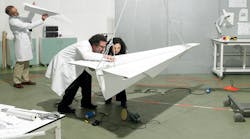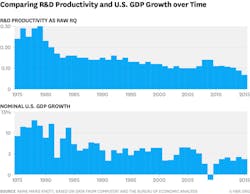Over the past decade numerous studies and research efforts have consistently found that R&D productivity, a synonym for efficiency, is declining—across all industries. Indicators come from a number of sources across several different domains.
Eroom’s Law: From our daily life experience, many of us have already heard about the woes of the pharmaceutical and biotechnology industries. The decline is so prolific that a study published by Nature coined a new law, “Eroom’s Law.” Eroom’s Law is the opposite of the well-known Moore’s Law, which describes the geometric growth of computing power over time. Thankfully, the Eroom trends are not as alarming in other industries.
Intellectual Property Indicators: Patents are one measure of innovation productivity. Thomson Reuters’ 6th State of Innovation Report in 2015 showed a slowing in the growth of global patent filings from 20% in 2012, to 17.7% in 2013, to 3.3 % in 2014. The absolute number of filings is increasing, but the growth is slowing. Thomson spun out Clarivate Analytics and their 8th State of Innovation Report in 2017 showed growth at 8%. The news is possibly better in the U.S. and Europe. China now accounts for six of every 10 patented inventions and has slowed disproportionately.
Research Quotient Indicators: A metric invented just five years ago, Research Quotient (RQ), is the first of its kind. It seeks to tie the inputs into R&D to the outputs from R&D, true R&D productivity. Given two- to five-year development cycles followed by two- to five-year commercialization cycles, RQ takes some work to calculate. But we are now in the era of big data. Metrics are a byproduct of analytics. The third HBR Article on RQ, “Is R&D Getting Harder, or Are Companies Just Getting Worse At It?” (March 2017), uses three decades of data to show a 65% decline in R&D productivity. My apologies to all readers, please don't shoot the messenger. Further, comparing these 30 years’ worth of data to U.S. GDP over the same period shows a near parallel relationship to U.S. GDP decline.
For me, 70% was too high and 10 to 20% is too low. As well, R&D will likely have a greater impact in the years ahead. Automation has already replaced much of the labor in distribution and production, and is now entering retail and administration. R&D, Product Development, Innovation, and IP will play increasing roles in driving industries and overall domestic productivity.











